Wildfire Mitigation and Evaluation of Firebreaks Through FlamMap Simulations in High-Susceptibility Areas of the Metropolitan District of Quito
Abstract
1. Introduction
2. Materials and Methods
2.1. Data Selection
2.2. Data Processing
2.2.1. Study Areas
2.2.2. Landscape Input Data
2.2.3. Meteorological Data
2.3. Simulation and Validation
2.3.1. Simulation in FlamMap and Firebreaks Evaluation
2.3.2. Sorensen and Kappa Coefficients Validation
- a is the number of pixels correctly classified as burned in both datasets;
- b is the number of pixels classified as burned only in the simulation;
- c is the number of pixels classified as burned only in the reference data.
- is the observed agreement (i.e., the proportion of correctly classified pixels);
- is the expected agreement by chance.
3. Results
4. Discussion
5. Conclusions
- 1.
- The simulation results show that adapting existing barriers (e.g., roads and trails) and creating additional strategically located firebreaks could reduce burned areas by up to 70%. However, firebreak effectiveness depends on multiple factors, particularly meteorological conditions, such as wind speed and humidity, emphasizing the need to incorporate environmental variability in mitigation planning.
- 2.
- The use of publicly available geospatial and meteorological data, combined with free simulation software, such as FlamMap version 6.1, enables preliminary wildfire behavior modeling in regions with limited resources. This approach offers a cost-effective tool for initial risk assessment and mitigation planning.
- 3.
- Although the national land-cover maps used were not specifically designed for fire behavior analysis, the approximation of MAGAP classes to Scott and Burgan fuel models achieved an acceptable simulation accuracy, with a Sorensen coefficient of 0.79 and a Cohen’s kappa of 0.77, demonstrating the potential of adapting the available data for wildfire simulations.
- 4.
- While the adapted data proved useful, developing localized fuel models remains essential to improve the simulation results. Future efforts could combine remote sensing with field sampling to better characterize the fuel properties in Andean ecosystems. This characterization could also support the identification of low-flammability native vegetation, enabling the exploration of alternative approaches, such as green firebreaks, which can help reduce the fire spread while reducing ecological impacts.
- 5.
- Beyond technical factors, the feasibility of establishing and maintaining firebreak infrastructure includes institutional, financial, and land management challenges. Multi-stakeholder collaboration, including local governments, technical agencies, communities, and academia, is essential for designing and implementing wildfire mitigation strategies that are both technically effective and socially viable.
Author Contributions
Funding
Institutional Review Board Statement
Informed Consent Statement
Data Availability Statement
Conflicts of Interest
Abbreviations
| CAWFE | Coupled Atmosphere–Wildland Fire Environment |
| DEM | Digital Elevation Model |
| DMQ | Metropolitan District of Quito |
| ESA | European Space Agency |
| FIRMS | Fire Information for Resource Management System |
| IGM | Military Geographic Institute of Ecuador |
| MAGAP | Ministry of Agriculture and Livestock of Ecuador |
| MTT | Minimum Time to Travel |
| REMMAQ | Metropolitan Atmospheric Monitoring Network of Quito |
References
- Weber, K.T.; Yadav, R. Spatiotemporal Trends in Wildfires across the Western United States (1950–2019). Remote Sens. 2020, 12, 2959. [Google Scholar] [CrossRef]
- Povak, N.A.; Hessburg, P.F.; Salter, R.B. Evidence for scale-dependent topographic controls on wildfire spread. Ecosphere 2018, 9, e02443. [Google Scholar] [CrossRef]
- Benson, R.P.; Roads, J.O.; Weise, D.R. Chapter 2 Climatic and Weather Factors Affecting Fire Occurrence and Behavior. Dev. Environ. Sci. 2008, 8, 37–59. [Google Scholar] [CrossRef]
- Balik, J.A.; Coop, J.D.; Krawchuk, M.A.; Naficy, C.E.; Parisien, M.A.; Parks, S.A.; Stevens-Rumann, C.S.; Whitman, E. Biogeographic patterns of daily wildfire spread and extremes across North America. Front. For. Glob. Change 2024, 7, 1355361. [Google Scholar] [CrossRef]
- Pourmohamad, Y.; Abatzoglou, J.T.; Fleishman, E.; Short, K.C.; Shuman, J.; AghaKouchak, A.; Williamson, M.; Seydi, S.T.; Sadegh, M. Inference of Wildfire Causes From Their Physical, Biological, Social and Management Attributes. Earth’s Future 2025, 13, e2024EF005187. [Google Scholar] [CrossRef]
- Coen, J.L.; Patton, E.G. Modeling wildland fires: A description of the Coupled Atmosphere-Wildland Fire Environment (CAWFE) model. Ncar Tech. Note 2010, 511, 3–38. [Google Scholar] [CrossRef]
- Mandel, J.; Beezley, J.D.; Kochanski, A.K. Coupled atmosphere-wildland fire modeling with WRF-Fire. Geosci. Model Dev. 2011, 4, 591–610. [Google Scholar] [CrossRef]
- Burge, J.; Bonanni, M.R.; Hu, R.L.; Ihme, M. Recurrent Convolutional Deep Neural Networks for Modeling Time-Resolved Wildfire Spread Behavior. arXiv 2022, arXiv:2210.16411. [Google Scholar] [CrossRef]
- Mitra, K.; Peng, Q.; Reisch, C. Studying wildfire fronts using advection–diffusion–reaction models. arXiv 2024, arXiv:2401.17468. [Google Scholar] [CrossRef]
- Finney, M.A. FARSITE: Fire Area Simulator—Model Development and Evaluation. USDA Forest Service; Rocky Mountain Research Station: Fort Collins, CO, USA, 1998. [Google Scholar] [CrossRef]
- Finney, M.A. An Overview of FlamMap Fire Modeling Capabilities. In Fuels Management—How to Measure Success; Rocky Mountain Research Station: Fort Collins, CO, USA, 2006; pp. 213–220. [Google Scholar]
- Kudlackova, L.; de Podebradska, M.; Blahova, M.; Cienciala, E.; Beranova, J.; McHugh, C.; Finney, M.; Novotny, J.; Zahradnicek, P.; Stepanek, P.; et al. Using Flammap to Assess Wildfire Behavior in Bohemian Switzerland National Park. Nat. Hazards 2024, 120, 3943–3977. [Google Scholar] [CrossRef]
- Khalaf, M.W.A.; Shataee, S.; Jahdi, R. Performance Analysis of ConvLSTM, FlamMap, and CA Algorithms to Predict Wildfire Spread in Golestan National Park, NE Iran. Environ. Model. Assess. 2024, 29, 489–502. [Google Scholar] [CrossRef]
- Yavuz, M.; Sağlam, B.; Kucuk, O.; Tufekcioglu, A. Assessing forest fire behavior simulation using FlamMap software and remote sensing techniques in Western Black Sea Region, Turkey. J. For. Fac. Kastamonu Univ. 2018, 18, 171–188. [Google Scholar] [CrossRef]
- Lovreglio, R.; Lovreglio, J.; Satta, G.G.A.; Mura, M.; Pulina, A. Assessing the Role of Forest Grazing in Reducing Fire Severity: A Mitigation Strategy. Fire 2024, 7, 409. [Google Scholar] [CrossRef]
- Lara, J.G.M.; Mendoza, C.I.A.; Coronel, L.J.J. Assessment of fuel related data in the metropolitan district of quito for modeling and simulation of wildfires, case study: Atacazo hill wildfire; [EvaluaciÓn de informaciÓn relacionada con combustibles en el distrito metropolitano de quito para el modelado y simulaciÓn de incendios forestales, caso de estudio: Incendio del cerro atacazo]. Granja 2021, 34, 43–59. [Google Scholar] [CrossRef]
- Mollocana Lara, J.G.; Paredes Obando, J.B. Assessment and Selection of Fuel Models in Areas with High Susceptibility to Wildfires in the Metropolitan District of Quito. In Innovation and Research—Smart Technologies & Systems; Vizuete, M.Z., Botto-Tobar, M., Casillas, S., Gonzalez, C., Sánchez, C., Gomes, G., Durakovic, B., Eds.; Springer: Cham, Switzerland, 2024; pp. 54–68. [Google Scholar] [CrossRef]
- Arias-Muñoz, P.; Cabrera-García, S.; Jácome-Aguirre, G. A Multicriteria Geographic Information System Analysis of Wildfire Susceptibility in the Andean Region: A Case Study in Ibarra, Ecuador. Fire 2024, 7, 81. [Google Scholar] [CrossRef]
- Security Secretariat of the Metropolitan District of Quito. Natural Hazards Atlas of the Metropolitan District of Quito; Municipality of the Metropolitan District of Quito: Quito, Ecuador, 2020. [Google Scholar]
- Ministry of Agriculture and Livestock of Ecuador (MAGAP). Vegetation Cover and Land Use Maps of Ecuador. MAGAP, National Geographic Information System. 2024. Available online: http://www.sigtierras.gob.ec/geoportal/ (accessed on 30 July 2023).
- Military Geographic Institute of Ecuador (IGM). Cartographic Base of Ecuador: Contour Lines and Topographic Data. Scale 1:50,000. Quito, Ecuador. 2024. Available online: https://www.geoportaligm.gob.ec/portal/index.php/cartografia-de-libre-acceso-escala-50k/ (accessed on 30 July 2023).
- NASA FIRMS. Fire Information for Resource Management System (FIRMS). NASA Earth Science, EOSDIS, MODIS and VIIRS Active Fire Data. 2024. Available online: https://firms.modaps.eosdis.nasa.gov/ (accessed on 30 July 2023).
- Metropolitan Atmospheric Monitoring Network of Quito (REMMAQ). Atmospheric Records of the Metropolitan District of Quito. Meteorological Data Obtained From Urban Monitoring Stations in Quito. 2024. Available online: https://datosambiente.quito.gob.ec/ (accessed on 30 July 2023).
- ESA. Sentinel-2 Data from Sentinel Hub Copernicus Browser. 2024. Available online: https://sentinel-hub.com (accessed on 30 July 2023).
- OpenStreetMap Contributors. OpenStreetMap: Geospatial Data for Global Mapping. Open Data Licensed Under the Open Database License (ODbL). 2024. Available online: https://www.openstreetmap.org/ (accessed on 30 July 2023).
- Scott, J.H.; Burgan, R.E. Standard Fire Behavior Fuel Models: A Comprehensive Set for Use with Rothermel’s Surface Fire Spread Model; Technical Report RMRS-GTR-153; U.S. Department of Agriculture, Forest Service, Rocky Mountain Research Station: Fort Collins, CO, USA, 2005. [Google Scholar]
- Jahdi, R.; Salis, M.; Darvishsefat, A.A.; Alcasena, F.; Mostafavi, M.A.; Etemad, V.; Lozano, O.M.; Spano, D. Evaluating fire modelling systems in recent wildfires of the Golestan National Park, Iran. Forestry 2015, 89, 136–149. [Google Scholar] [CrossRef]
- Ning, J.; LiU, H.; Yu, W.; Deng, J.; Sun, L.; Yang, G.; Wang, M.; Yu, H. Comparison of Different Models to Simulate Forest Fire Spread: A Case Study. Forest 2024, 15, 563. [Google Scholar] [CrossRef]
- Gharakhanlou, N.M.; Hooshangi, N. Validation of a GIS-based cellular automata model for wildfire spread using Kappa coefficient analysis. Int. J. Wildland Fire 2021, 30, 456–468. [Google Scholar] [CrossRef]
- Elia, M.; Lafortezza, R.; Lovreglio, R.; Sanesi, G. Developing Custom Fire Behavior Fuel Models for Mediterranean Wildland–Urban Interfaces in Southern Italy. Environ. Manag. 2015, 56, 754–764. [Google Scholar] [CrossRef]
- Carrasco, J.; Mahaluf, R.; Lisón, F.; Pais, C.; Miranda, A.; de la Barra, F.; Palacios, D.; Weintraub, A. A firebreak placement model for optimizing biodiversity protection at landscape scale. J. Environ. Manag. 2023, 342, 118087. [Google Scholar] [CrossRef]
- Cheney, N.P.; Sullivan, A.L. Width of firebreak that is necessary to stop grass fires: Some field experiments in Northern Australia. Can. J. For. Res. 1988, 18, 653–658. [Google Scholar] [CrossRef]
- Ortega, M.; Silva, F.R.; Molina, J.R. Modeling Fuel Break Effectiveness in Southern Spain Wildfires. Fire Ecol. 2024, 20, 40. [Google Scholar] [CrossRef]
- Zong, X.; Tian, X.; Wang, X. An optimal firebreak design for the boreal forest of China. Sci. Total Environ. 2021, 781, 146822. [Google Scholar] [CrossRef]
- Marshall, E.; Holyland, B.; Parkins, K.; Raulings, E.; Good, M.K.; Swan, M.; Bennett, L.T.; Penman, T.D. Can green firebreaks help balance biodiversity, carbon storage and wildfire risk? J. Environ. Manag. 2024, 369, 122183. [Google Scholar] [CrossRef] [PubMed]
- Cui, X.; Alam, M.A.; Perry, G.L.; Paterson, A.M.; Wyse, S.V.; Curran, T.J. Green firebreaks as a management tool for wildfires: Lessons from China. J. Environ. Manag. 2019, 233, 329–336. [Google Scholar] [CrossRef]
- Kirschner, J.A.; Clark, J.; Boustras, G. Governing Wildfires: Toward a Systematic Analytical Framework. Ecol. Soc. 2023, 28, 6. [Google Scholar] [CrossRef]

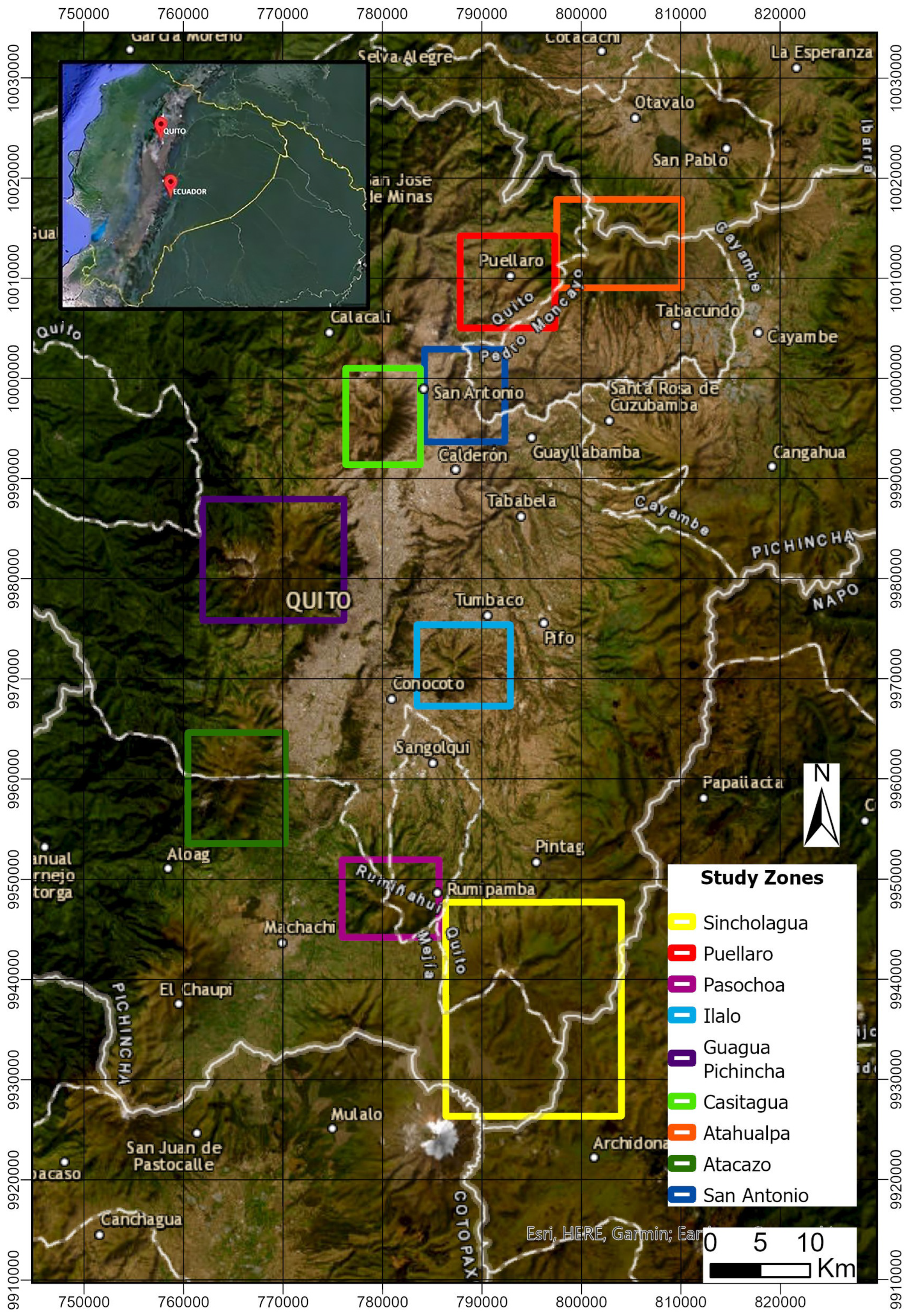

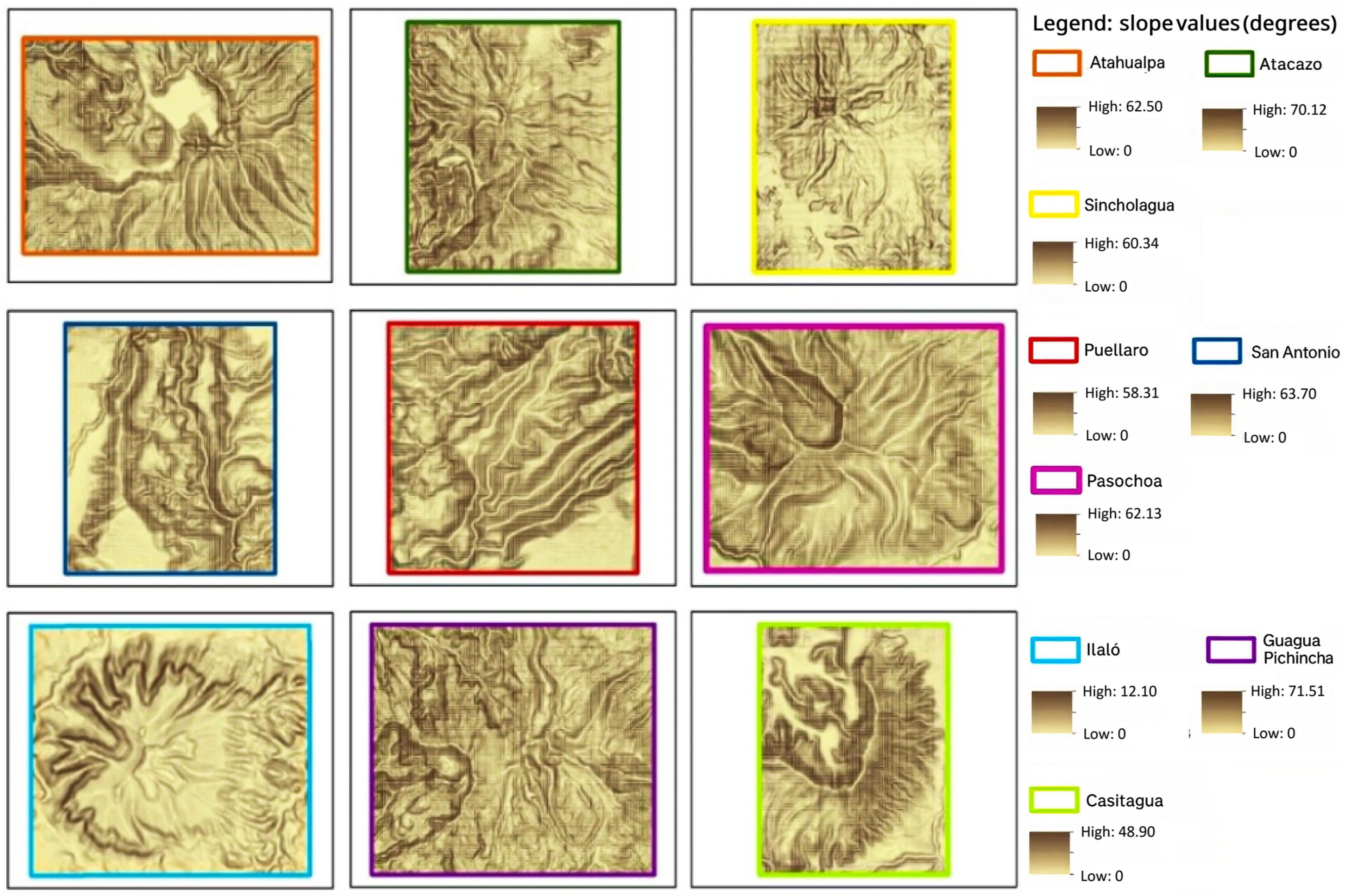
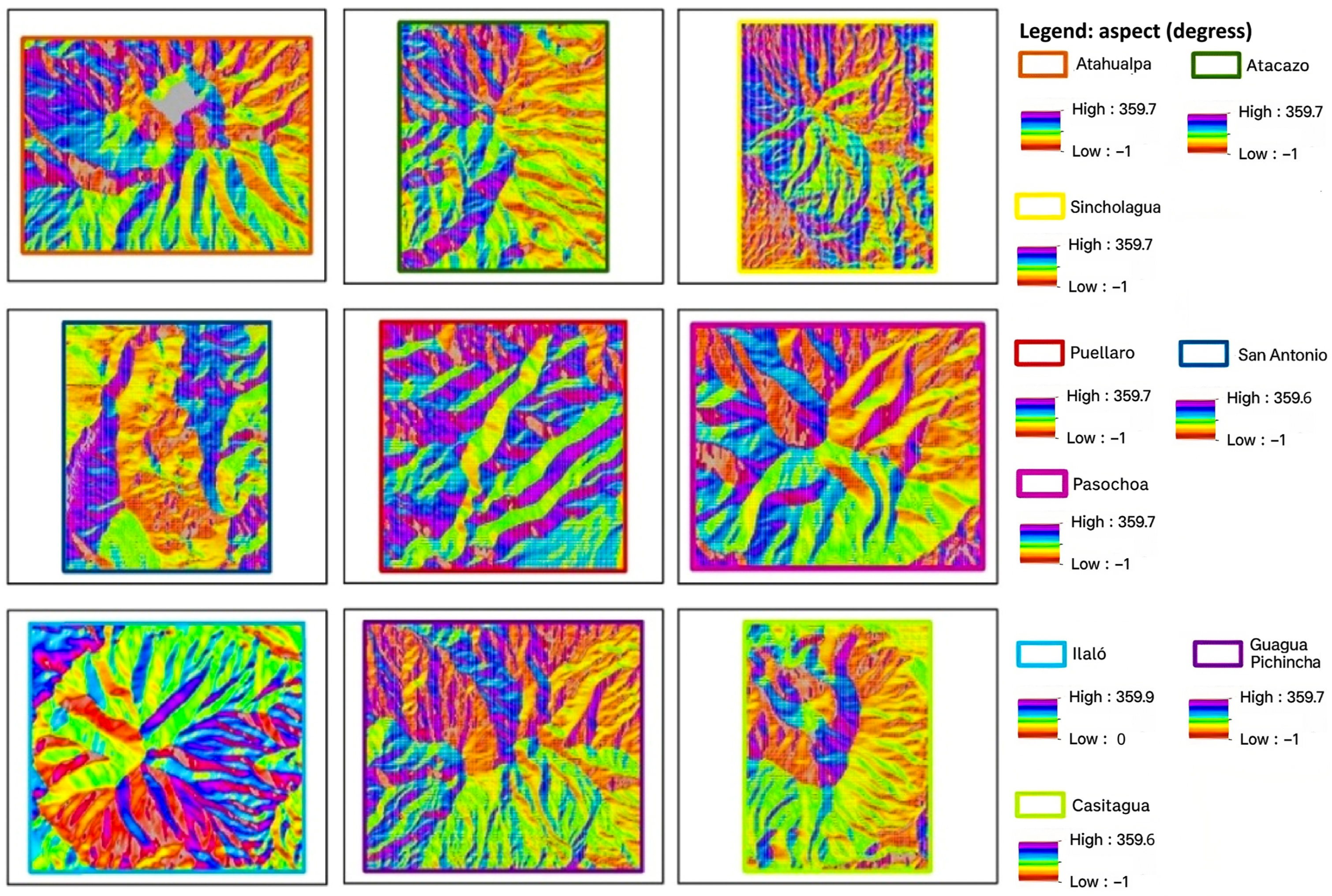
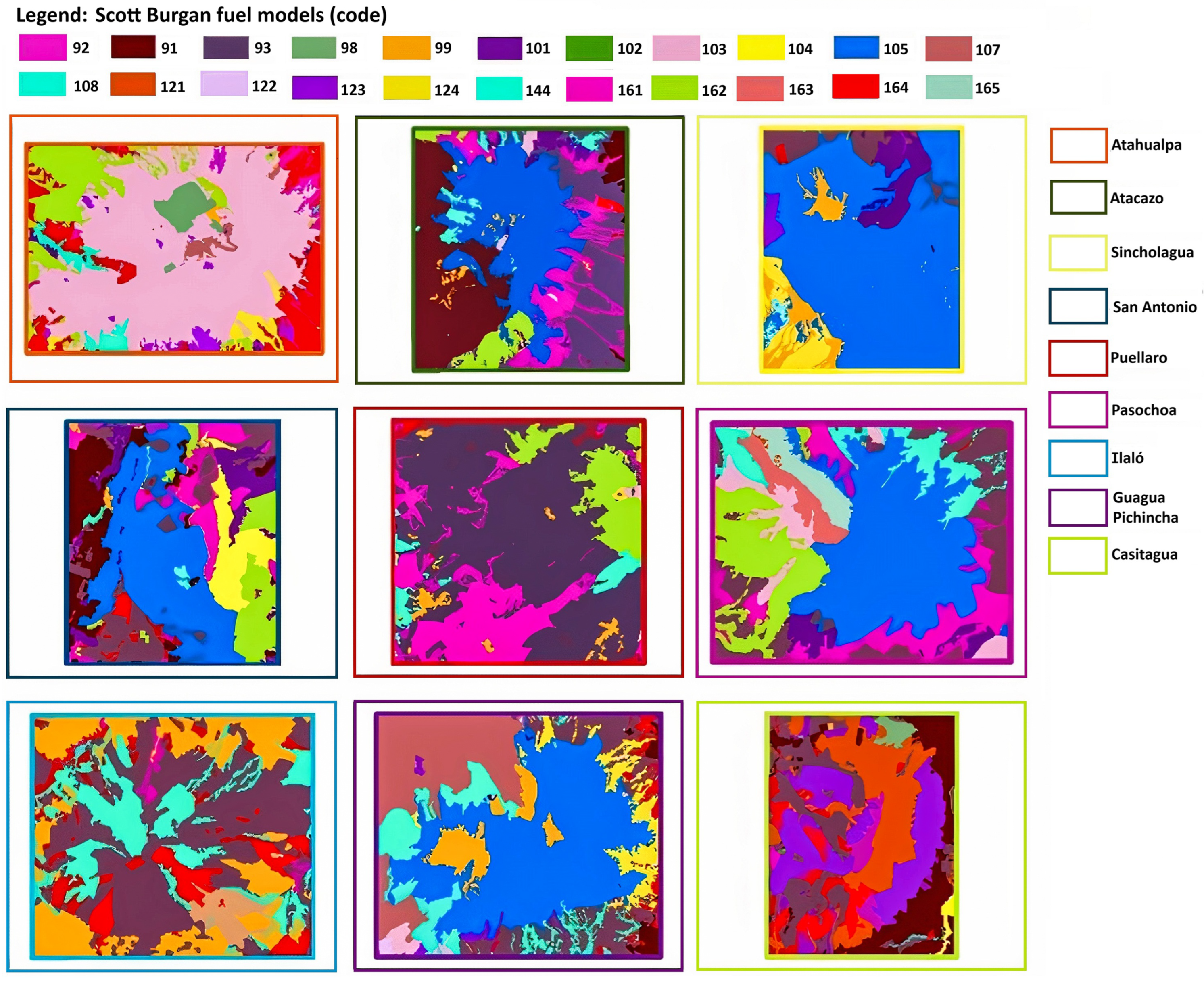
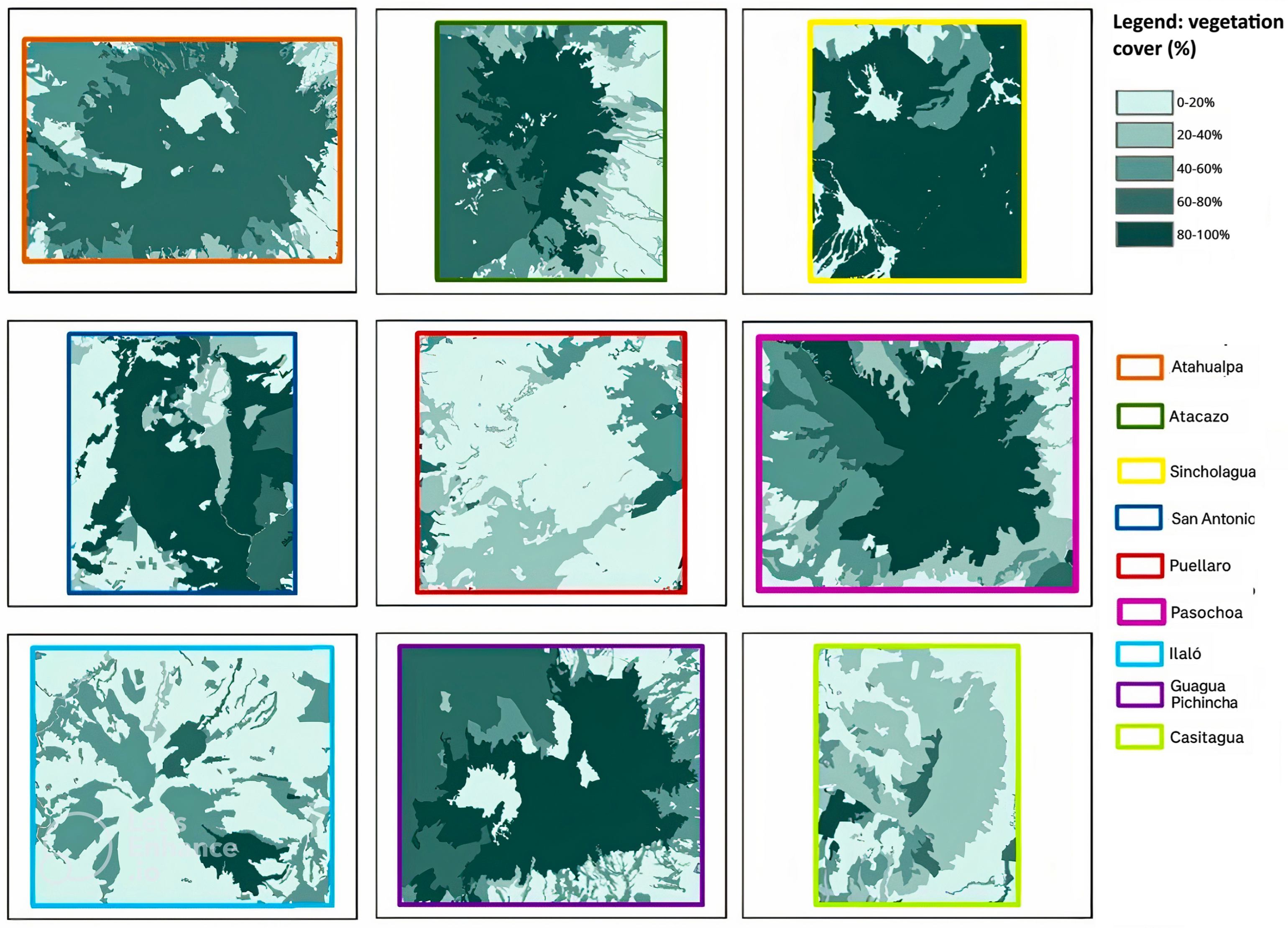
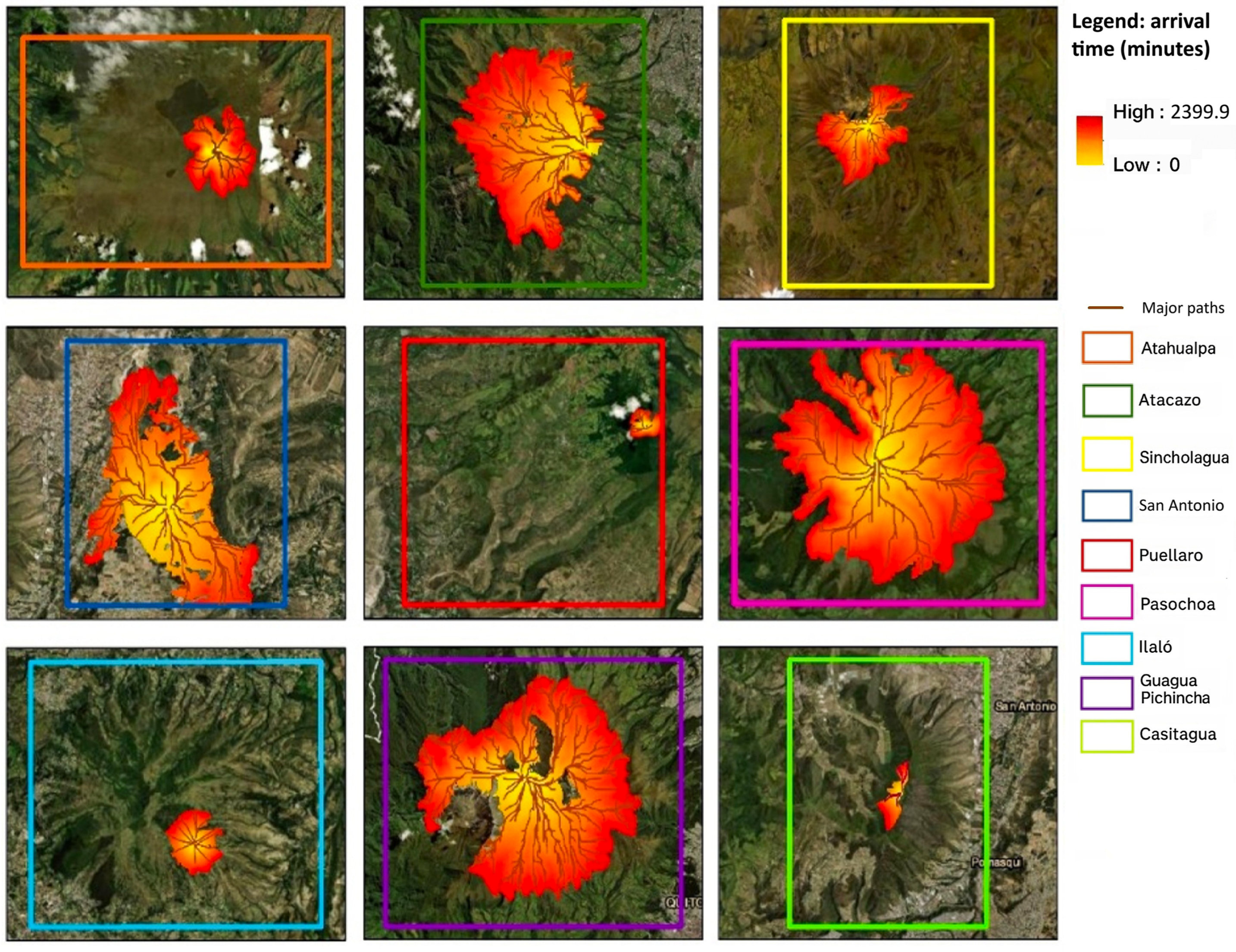
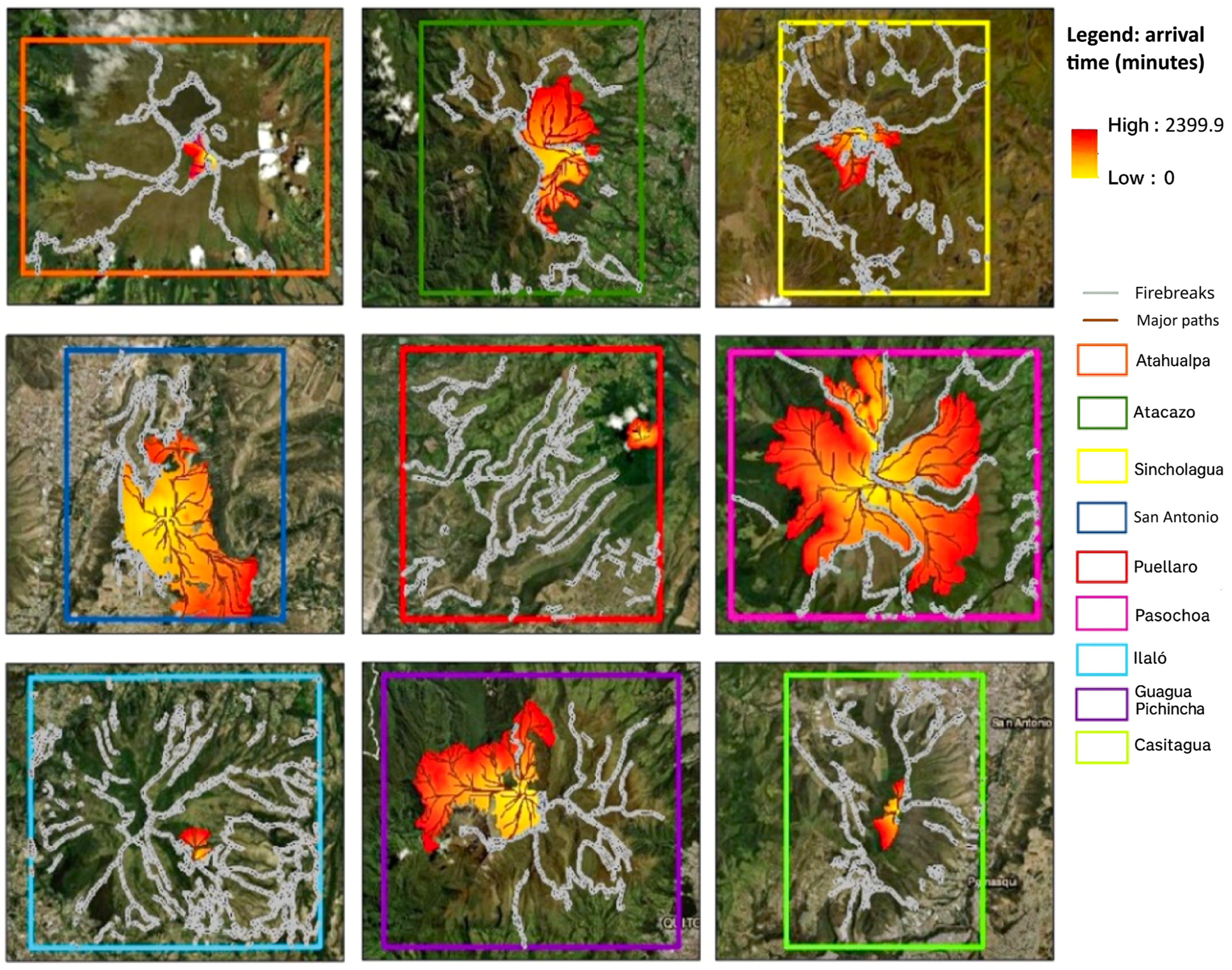
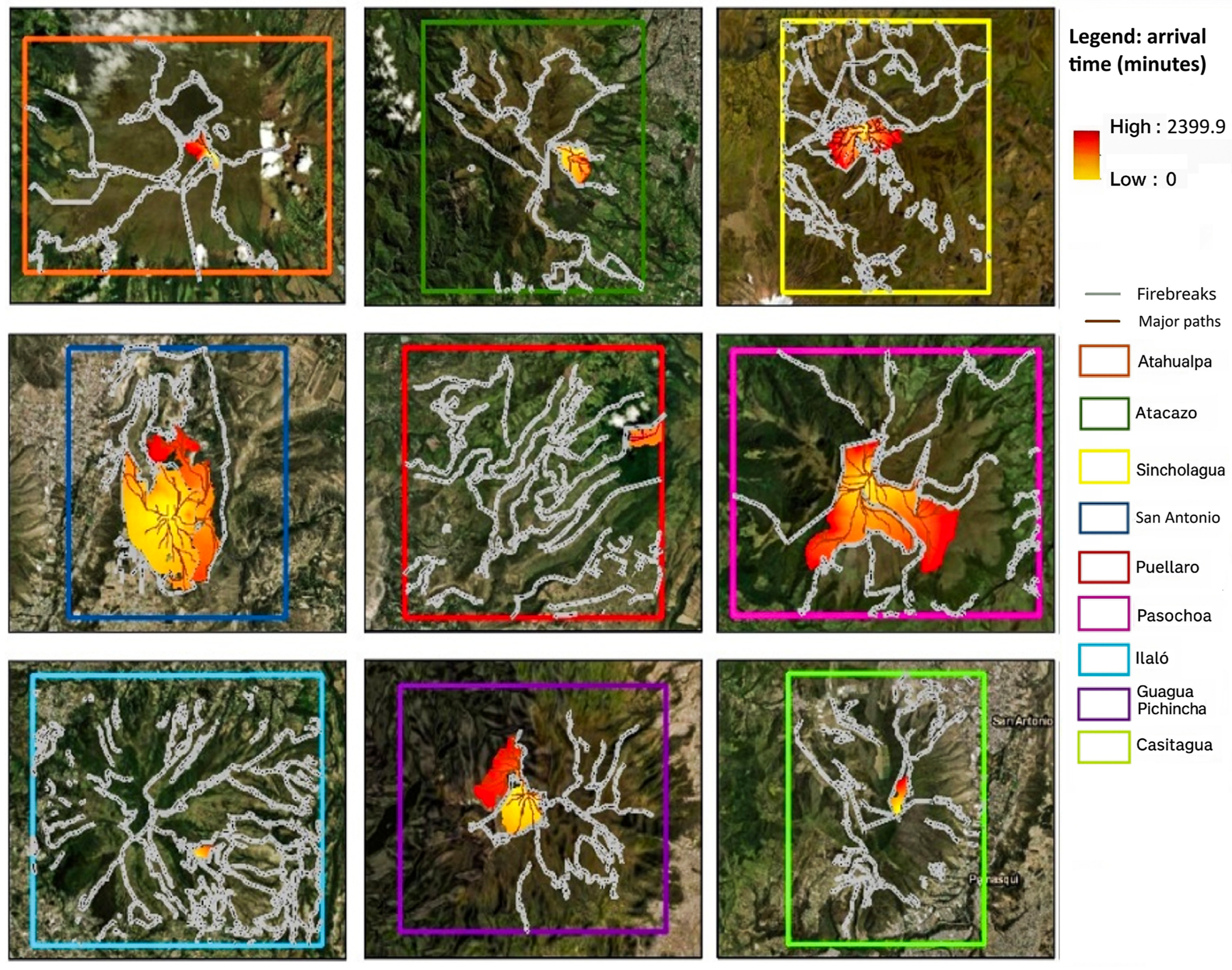
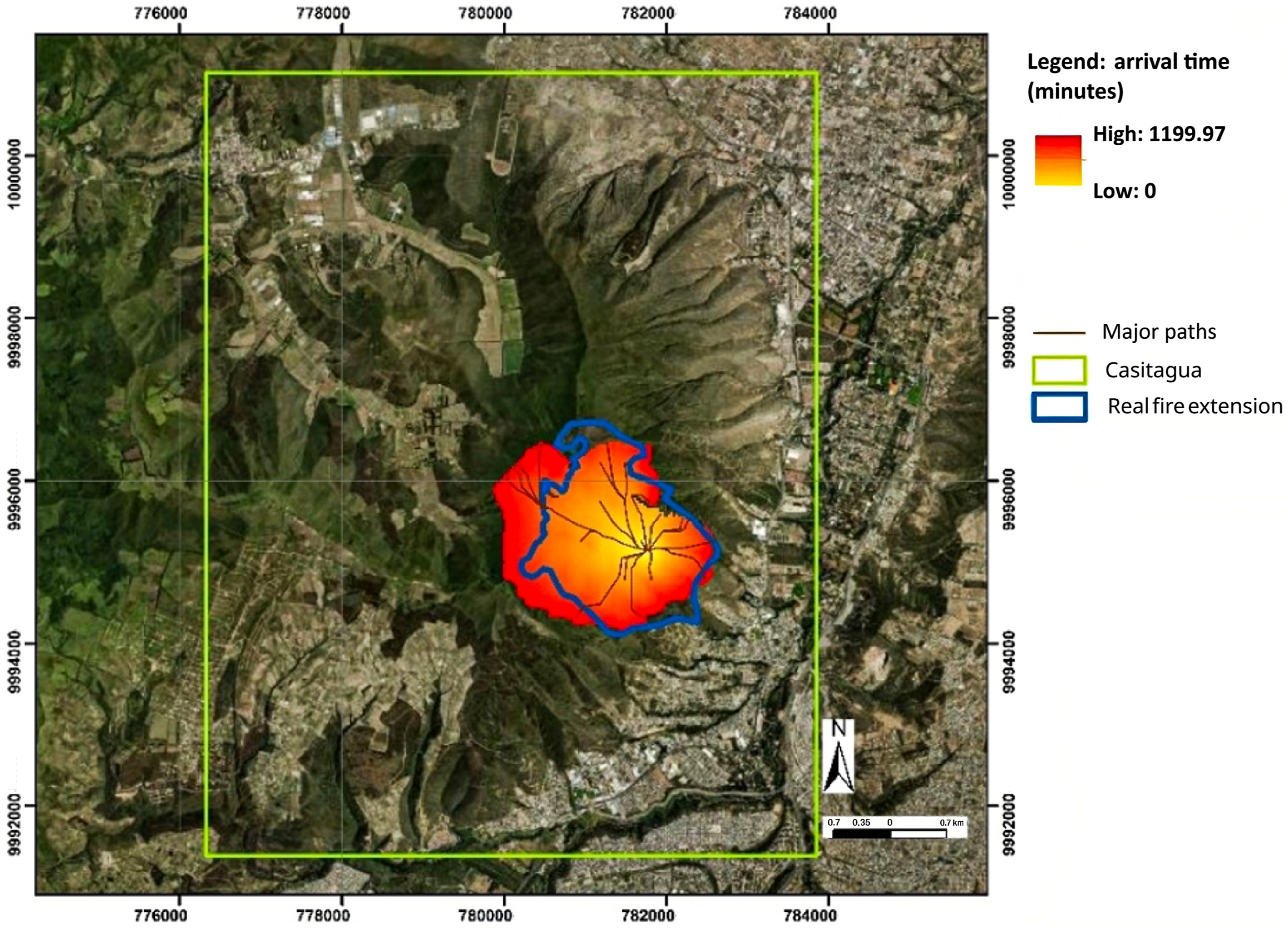
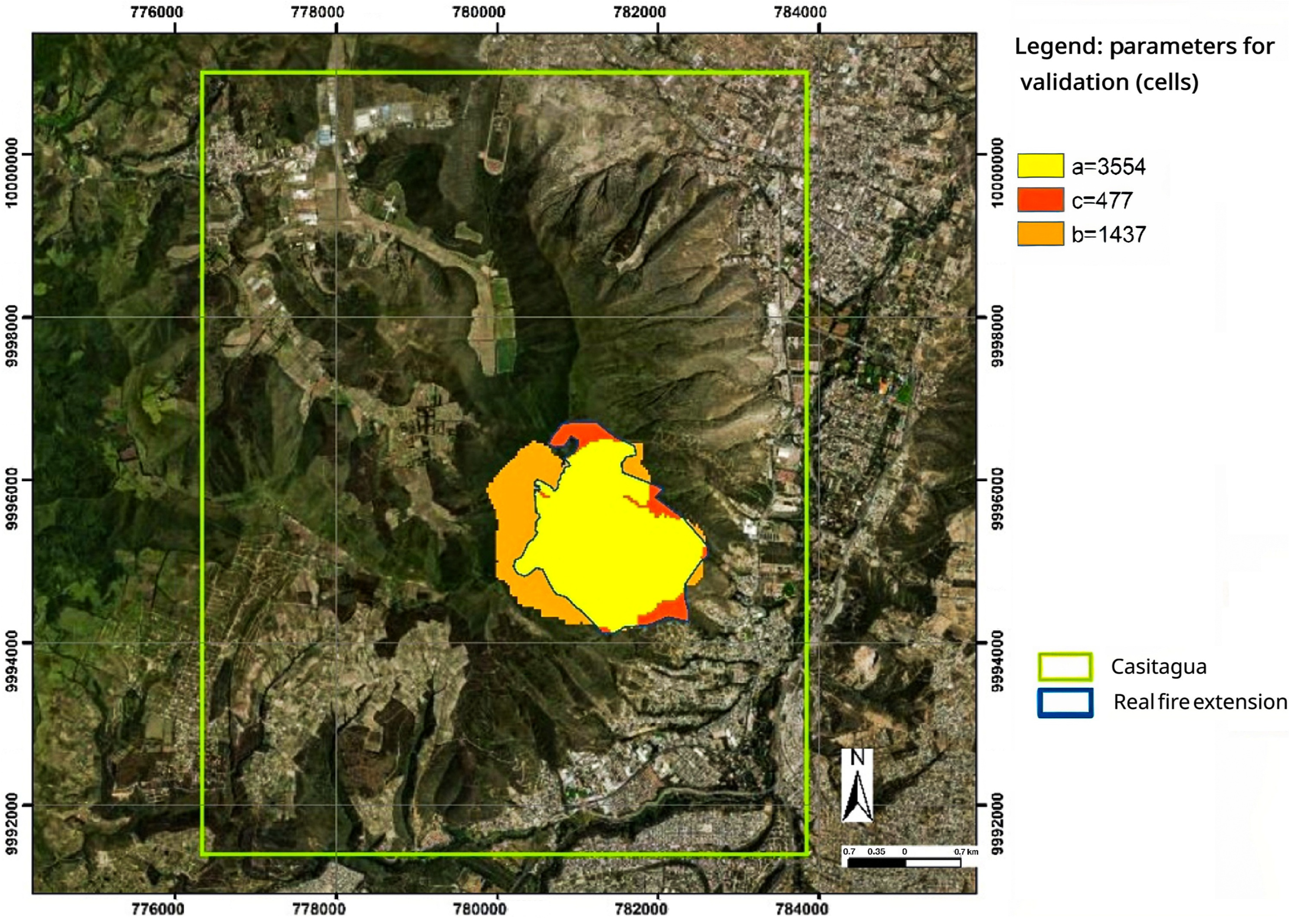
| Data | Source |
|---|---|
| Wildfire susceptibility areas | Natural Hazards Atlas of the Metropolitan District of Quito [19] |
| Land-cover maps | Ministry of Agriculture and Livestock of Ecuador (MAGAP) [20] |
| Topographic contour lines | Military Geographic Institute of Ecuador (IGM) [21] |
| Wildfire records and possible ignition points | Fire Information for Resource Management System (FIRMS-NASA) [22] |
| Meteorological data | Metropolitan Atmospheric Monitoring Network (REMMAQ) [23] |
| Past wildfires extension | European Space Agency (ESA) Sentinel-2 Satellite Imagery [24] |
| Potential firebreaks | OpenStreetMap (OSM) [25] |
| MAGAP Class | Fuel Model (Code) | Fuel Model Description |
|---|---|---|
| Urban and built-up classes (populated centers, military, industrial, recreational, educational facilities, etc.) | NB1 (91) | Urban or suburban areas with insufficient wildland fuel to support fire spread. |
| Glacier | NB2 (92) | Areas permanently covered by snow or ice. |
| Agricultural classes (various crops, greenhouses, pastures, farms, etc.) | NB3 (93) | Agricultural land maintained in a nonburnable condition. |
| Water bodies classes (lakes, lagoons, rivers, reservoirs, etc.) | NB8 (98) | Open water, such as lakes, rivers, and oceans. |
| Bare ground classes (eroded land, bare ground, mines, rock formations, etc.) | NB9 (99) | Bare ground with insufficient fuel to carry fire, such as sand, gravel, or rock. |
| Highly altered dry herbaceous vegetation | GR1 (101) | Short, sparse dry climate grass. |
| Moderately altered dry herbaceous vegetation | GR2 (102) | Low-load, dry climate grass with more continuity than GR1. |
| Highly altered herbaceous paramo | GR3 (103) | Very coarse, humid climate grass with a low load. |
| Slightly altered dry herbaceous vegetation | GR4 (104) | Moderate-load, dry climate grass. |
| Moderately altered herbaceous paramo | GR5 (105) | Low-load, humid climate grass; greater than GR3. |
| Herbaceous vegetation | GR7 (107) | High-load, dry climate grass. |
| Paramo | GR8 (108) | High-load, very coarse, humid climate grass. |
| Moderately altered dry scrubland | GS1 (121) | Low-load, dry climate grass–shrub. |
| Highly altered dry scrubland and slightly altered dry scrubland | GS2 (122) | Moderate-load, dry climate grass–shrub. |
| Highly altered paramo shrubland, moderately altered paramo shrubland, and highly altered humid scrub | GS3 (123) | Moderate-load, humid climate grass–shrub. |
| Slightly altered paramo shrubland, slightly altered humid scrub, and moderately altered humid scrub | GS4 (124) | High-load, humid climate grass–shrub. |
| Highly altered humid forest | SH4 (144) | Low-load, humid climate timber–shrub. |
| Highly altered dry forest | TU1 (161) | Low-load, dry climate timber–grass–shrub. |
| Moderately altered humid forest | TU2 (162) | Moderate-load, humid climate timber–shrub. |
| Slightly altered humid forest | TU3 (163) | Moderate-load, humid climate timber–grass–shrub. |
| Pine forest | TU4 (164) | Dwarf conifer with understory. |
| Native forest | TU5 (165) | Very high load, dry climate timber–shrub. |
| Study Area | Without Firebreaks (m²) | With Firebreaks (m²) | With Additional Firebreaks (m²) | Mitigation with Firebreaks (%) | Mitigation with Additional Firebreaks (%) |
|---|---|---|---|---|---|
| Atahualpa | 221,520 | 47,730 | 33,810 | 78.5 | 84.7 |
| Atacazo | 1,134,600 | 402,210 | 54,960 | 64.6 | 95.2 |
| Casitagua | 39,780 | 39,390 | 14,340 | 1.0 | 64.0 |
| Guagua Pichincha | 2,058,780 | 705,120 | 275,820 | 65.8 | 86.6 |
| Ilaló | 78,900 | 21,810 | 7470 | 72.4 | 90.5 |
| Sincholagua | 1,036,860 | 566,460 | 380,280 | 45.4 | 63.3 |
| Pasochoa | 1,123,860 | 849,270 | 278,820 | 24.4 | 75.2 |
| Puéllaro | 30,690 | 30,690 | 24,180 | 0.0 | 21.2 |
| San Antonio | 824,250 | 567,300 | 405,810 | 31.2 | 50.8 |
| Simulated Burned | Simulated Not Burned | Total | |
|---|---|---|---|
| Real burned | 3554 (a) | 1437 (b) | 4991 |
| Real not burned | 477 (c) | 75,103 (d) | 75,580 |
| Total | 4037 | 76,540 | 80,571 |
Disclaimer/Publisher’s Note: The statements, opinions and data contained in all publications are solely those of the individual author(s) and contributor(s) and not of MDPI and/or the editor(s). MDPI and/or the editor(s) disclaim responsibility for any injury to people or property resulting from any ideas, methods, instructions or products referred to in the content. |
© 2025 by the authors. Licensee MDPI, Basel, Switzerland. This article is an open access article distributed under the terms and conditions of the Creative Commons Attribution (CC BY) license (https://creativecommons.org/licenses/by/4.0/).
Share and Cite
Mollocana-Lara, J.G.; Obando-Proaño, K.J.; Córdova-Luspa, B.G. Wildfire Mitigation and Evaluation of Firebreaks Through FlamMap Simulations in High-Susceptibility Areas of the Metropolitan District of Quito. Fire 2025, 8, 189. https://doi.org/10.3390/fire8050189
Mollocana-Lara JG, Obando-Proaño KJ, Córdova-Luspa BG. Wildfire Mitigation and Evaluation of Firebreaks Through FlamMap Simulations in High-Susceptibility Areas of the Metropolitan District of Quito. Fire. 2025; 8(5):189. https://doi.org/10.3390/fire8050189
Chicago/Turabian StyleMollocana-Lara, Juan Gabriel, Katiuska Jajaira Obando-Proaño, and Betsy Germania Córdova-Luspa. 2025. "Wildfire Mitigation and Evaluation of Firebreaks Through FlamMap Simulations in High-Susceptibility Areas of the Metropolitan District of Quito" Fire 8, no. 5: 189. https://doi.org/10.3390/fire8050189
APA StyleMollocana-Lara, J. G., Obando-Proaño, K. J., & Córdova-Luspa, B. G. (2025). Wildfire Mitigation and Evaluation of Firebreaks Through FlamMap Simulations in High-Susceptibility Areas of the Metropolitan District of Quito. Fire, 8(5), 189. https://doi.org/10.3390/fire8050189






